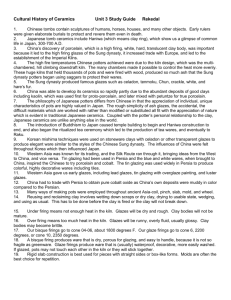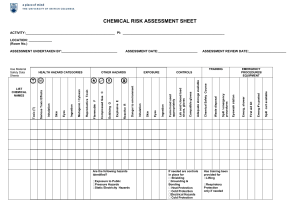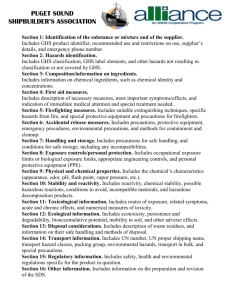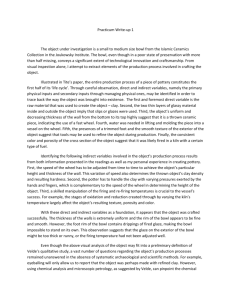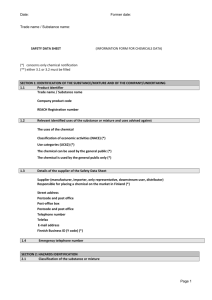Model risk assessment
advertisement
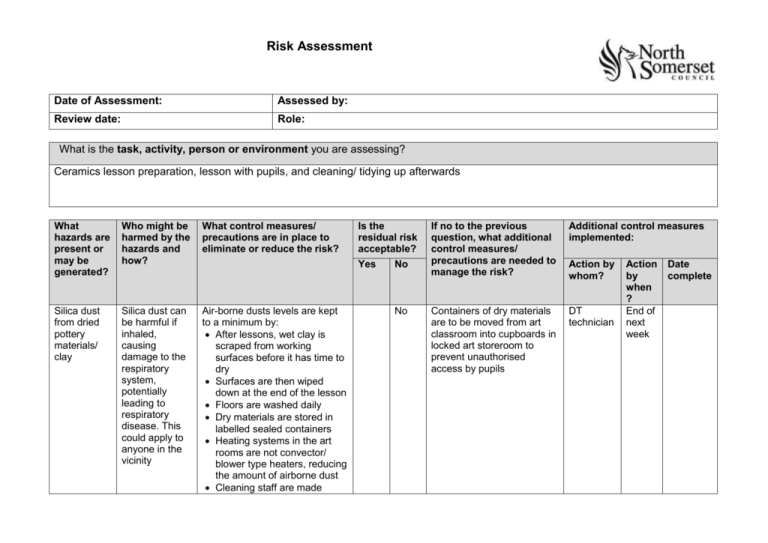
Risk Assessment Date of Assessment: Assessed by: Review date: Role: What is the task, activity, person or environment you are assessing? Ceramics lesson preparation, lesson with pupils, and cleaning/ tidying up afterwards What hazards are present or may be generated? Who might be harmed by the hazards and how? What control measures/ precautions are in place to eliminate or reduce the risk? Silica dust from dried pottery materials/ clay Silica dust can be harmful if inhaled, causing damage to the respiratory system, potentially leading to respiratory disease. This could apply to anyone in the vicinity Air-borne dusts levels are kept to a minimum by: After lessons, wet clay is scraped from working surfaces before it has time to dry Surfaces are then wiped down at the end of the lesson Floors are washed daily Dry materials are stored in labelled sealed containers Heating systems in the art rooms are not convector/ blower type heaters, reducing the amount of airborne dust Cleaning staff are made Is the residual risk acceptable? Yes No No If no to the previous question, what additional control measures/ precautions are needed to manage the risk? Additional control measures implemented: Containers of dry materials are to be moved from art classroom into cupboards in locked art storeroom to prevent unauthorised access by pupils DT technician Action by whom? Action by when ? End of next week Date complete What hazards are present or may be generated? Who might be harmed by the hazards and how? What control measures/ precautions are in place to eliminate or reduce the risk? Yes Clay – skin contact Wet clay and glazes on floor Wet clay can cause dermatitis to anyone handling it repeatedly. Pupils are not likely to be at risk due to the short times they are handling it, but teachers/ technicians could be. Wet clay and glazes would create a slip hazard to anyone in the vicinity if dropped/ spilled on floor. Is the residual risk acceptable? aware of the need for wet cleaning methods wherever possible Pupils wear aprons which are washable/ wipe clean, and made to wash hands before leaving the classroom Staff made aware of possible signs of dermatitis e.g. red, dry or cracked skin Staff reduce the handling time as much as possible Staff wash hands regularly and use moisturisers Pupils told to pick up any clay they drop and inform an adult Floor is wiped immediately to remove clay or glaze. Signs used until the risk of slipping is removed Yes Yes No If no to the previous question, what additional control measures/ precautions are needed to manage the risk? Additional control measures implemented: Action by whom? Action by when ? Date complete What hazards are present or may be generated? Who might be harmed by the hazards and how? What control measures/ precautions are in place to eliminate or reduce the risk? Kilns Everyone who is in the building could be at risk if a fire started. Anyone coming in contact with the kiln could suffer burns. Unauthorised access by pupils, could potentially lead to burns, fires, etc The room is designed appropriately so a clear space of at least 45mm is kept around the kiln to aide ventilation, and there are air bricks in the wall adjacent to the kiln Combustible material is never stored on or around the kiln, even when it is not in use A carbon dioxide fire extinguisher is kept by the door of the kiln room Training is purchased from a competent specialist kiln company for staff that use kiln. Only trained adults to carry out firing process The kiln is regularly inspected by a competent specialist contractor (e.g. Celtic Kiln Care) The electrical isolation switch for the kiln is labelled and is in a convenient position The kiln is in a separate room, behind a locked door The door has a heat lock fitted, so it cannot be opened until the temperature decreases to a safe level after firing Is the residual risk acceptable? Yes No If no to the previous question, what additional control measures/ precautions are needed to manage the risk? Additional control measures implemented: Action by whom? Action by when ? Date complete What hazards are present or may be generated? Potter’s wheel Who might be harmed by the hazards and how? Trapping and entanglement hazards could affect anyone who uses the wheel. What control measures/ precautions are in place to eliminate or reduce the risk? Is the residual risk acceptable? Yes If left to fire overnight, the caretaker is informed whenever this takes place. He has emergency contact details of the person trained to use the kiln Operating instructions are on display in the kiln room, and include emergency procedures Moving parts e.g. the belt and pulley drives are completely enclosed by guards, which have a fail-safe on them to prevent the wheel being switched on whilst the guard is not on Pupils are allowed to use the wheel, but only with one-toone supervision levels. Long hair is always tied back, and ties taken off before using the wheel The wheel is situated in a corner of the classroom, away from the paths through the classroom with the highest footfall No If no to the previous question, what additional control measures/ precautions are needed to manage the risk? Additional control measures implemented: Action by whom? Action by when ? Date complete What hazards are present or may be generated? Who might be harmed by the hazards and how? What control measures/ precautions are in place to eliminate or reduce the risk? Glazes The materials used in glazes can be irritant, harmful or even toxic to anyone by skin contact, ingestion or inhalation Materials for which a material safety data sheet is not available are not used Pupils and guardians are told that pottery items are decorative and not intended to be used with food or drink products Glazes are prepared by the art technician only, by adding the dry glaze material to water, and not vice versa, to reduce dust formation. Gloves and an apron are worn Adequate first aid and eye wash facilities are available Only leadless (<1% lead) glazes are used No one is allowed to eat or drink in the art room Glazes kept in locked art storeroom Dry cleaning methods are not used and staff are aware of the hazards Is the residual risk acceptable? Yes No If no to the previous question, what additional control measures/ precautions are needed to manage the risk? Additional control measures implemented: Action by whom? Action by when ? Date complete

